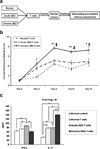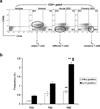Chronic dry eye disease is principally mediated by effector memory Th17 cells
- PMID: 23571503
- PMCID: PMC3732510
- DOI: 10.1038/mi.2013.20
Chronic dry eye disease is principally mediated by effector memory Th17 cells
Abstract
Recent experimental and clinical data suggest that there is a link between dry eye disease (DED) and T-cell-mediated immunity. However, whether these immune responses are a consequence or cause of ocular surface inflammation remains to be determined. Thus far, only models of acute DED have been used to derive experimental data. This is in contrast to clinical DED which usually presents as a chronic disease. In the present study, using a murine model of chronic DED, it was established that the chronic phase of the disease is accompanied by T helper type 17 (Th17) responses at the ocular surface and that a significant memory T-cell population can be recovered from chronic DED. This memory response is predominantly mediated by Th17 cells. Moreover, adoptive transfer of this memory T-cell population was shown to induce more severe and rapidly progressing DED than did the adoptive transfer of its effector or naive counterparts. Not only do these results clearly demonstrate that effector memory Th17 cells are primarily responsible for maintaining the chronic and relapsing course of DED, but they also highlight a potentially novel therapeutic strategy for targeting memory immune responses in patients with DED.
Conflict of interest statement
Conflict of interest: None.
Figures




Similar articles
-
The functions of IL-23 and IL-2 on driving autoimmune effector T-helper 17 cells into the memory pool in dry eye disease.Mucosal Immunol. 2021 Jan;14(1):177-186. doi: 10.1038/s41385-020-0289-3. Epub 2020 Apr 23. Mucosal Immunol. 2021. PMID: 32327706 Free PMC article.
-
Substance P regulates memory Th17 cell generation and maintenance in chronic dry eye disease.J Leukoc Biol. 2024 Nov 27;116(6):1446-1453. doi: 10.1093/jleuko/qiae142. J Leukoc Biol. 2024. PMID: 38916986
-
Activation of α2B/2C adrenergic receptor ameliorates ocular surface inflammation through enhancing regulatory T cell function.Mucosal Immunol. 2025 Feb;18(1):176-187. doi: 10.1016/j.mucimm.2024.11.002. Epub 2024 Nov 8. Mucosal Immunol. 2025. PMID: 39522611 Free PMC article.
-
Age-related Defects in Ocular and Nasal Mucosal Immune System and the Immunopathology of Dry Eye Disease.Ocul Immunol Inflamm. 2016 Jun;24(3):327-47. doi: 10.3109/09273948.2014.986581. Epub 2014 Dec 23. Ocul Immunol Inflamm. 2016. PMID: 25535823 Free PMC article. Review.
-
Cluster Analysis of Dry Eye Disease Models Based on Immune Cell Parameters - New Insight Into Therapeutic Perspective.Front Immunol. 2020 Sep 29;11:1930. doi: 10.3389/fimmu.2020.01930. eCollection 2020. Front Immunol. 2020. PMID: 33133058 Free PMC article.
Cited by
-
Current Advances in Regenerative Strategies for Dry Eye Diseases: A Comprehensive Review.Bioengineering (Basel). 2023 Dec 29;11(1):39. doi: 10.3390/bioengineering11010039. Bioengineering (Basel). 2023. PMID: 38247916 Free PMC article. Review.
-
Immune regulation of the ocular surface.Exp Eye Res. 2022 May;218:109007. doi: 10.1016/j.exer.2022.109007. Epub 2022 Mar 4. Exp Eye Res. 2022. PMID: 35257715 Free PMC article. Review.
-
The Immunological Basis of Dry Eye Disease and Current Topical Treatment Options.J Ocul Pharmacol Ther. 2020 Apr;36(3):137-146. doi: 10.1089/jop.2019.0060. Epub 2020 Mar 12. J Ocul Pharmacol Ther. 2020. PMID: 32175799 Free PMC article. Review.
-
Pigment Epithelium-Derived Factor Enhances the Suppressive Phenotype of Regulatory T Cells in a Murine Model of Dry Eye Disease.Am J Pathol. 2021 Apr;191(4):720-729. doi: 10.1016/j.ajpath.2021.01.003. Epub 2021 Jan 14. Am J Pathol. 2021. PMID: 33453179 Free PMC article.
-
Defining Dry Eye from a Clinical Perspective.Int J Mol Sci. 2020 Dec 4;21(23):9271. doi: 10.3390/ijms21239271. Int J Mol Sci. 2020. PMID: 33291796 Free PMC article. Review.
References
-
- Schaumberg DA, Sullivan DA, Buring JE, Dana MR. Prevalence of dry eye syndrome among US women. Am. J. Ophthalmol. 2003;136:318–326. - PubMed
-
- Subcommittee of the international Dry Eye Workshop. The definition and classification of dry eye disease: report of the Definition and Classification. Ocul. Surf. 2007;5:75–92. - PubMed
-
- Stern ME, et al. Conjunctival T cell subpopulations in Sjögren's and non-Sjögren's patients with dry eye. Invest. Ophthalmol. Vis. Sci. 2002;43:2609–2614. - PubMed
-
- Kunert KS, Tisdale AS, Stern ME, Smith JA, Gipson IK. Analysis of topical cyclosporine treatment of patients with dry eye syndrome: effect on conjunctival lymphocytes. Arch. Ophthalmol. 2000;118:1489–1496. - PubMed
Publication types
MeSH terms
Grants and funding
LinkOut - more resources
Full Text Sources
Other Literature Sources

